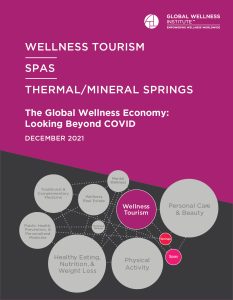Wellness Tourism, Spas, Thermal/Mineral Springs
The Global Wellness Economy: Looking Beyond COVID
Released December 2021
The GWI’s most in-depth research on wellness markets ever: For the first time, it provides detailed numbers and analysis for all eleven wellness sectors: pre-pandemic, pandemic, and future growth rates; rich regional and national data; and the major trends that will impact each sector post-COVID.
WELLNESS MARKET SNAPSHOTS
Wellness Tourism (pandemic loser, future winner): Grew 8% annually from 2017 to 2019 (reaching $720 billion) and then took a major hit in 2020. The market shrunk -39.5% to $436 billion, while wellness trips dropped from 936 million to 601 million. The impressive 21% annual growth rate projected for wellness tourism through 2025 reflects new traveler values (a quest for nature, sustainability, mental wellness) as well as a period of rapid recovery from pent-up demand in 2021 and 2022.
Spas (pandemic loser, future winner): From 2017 to 2019, the spa industry was growing at a fast 8.7% annual rate and reached $111 billion in revenues across 165,714 spas–with a big jump in hotel/resort spas (from 48,248 to 60,873). The high-touch industry got hit hard in 2020: Revenues fell by -39% (to $69 billion) and spa establishments dropped to 160,100 (with a loss of over 4,000 day spas). But the industry is expected to recover fast, with the market growing 17% annually through 2025, and more than doubling revenues (to $150.5 billion).
Thermal/Mineral Springs (pandemic loser, future winner): One of the fastest-growing wellness markets from 2017 to 2019, with revenues rising from $56 billion to $64 billion (6.8% annual growth). Hit hard by the pandemic, revenues fell -39% in 2020, shrinking the market to $39 billion. There are now 35,099 hot springs establishments across 130 countries. The downturn is temporary: Very strong 18% annual growth is expected through 2025, with 140-plus new projects in the pipeline.
























































